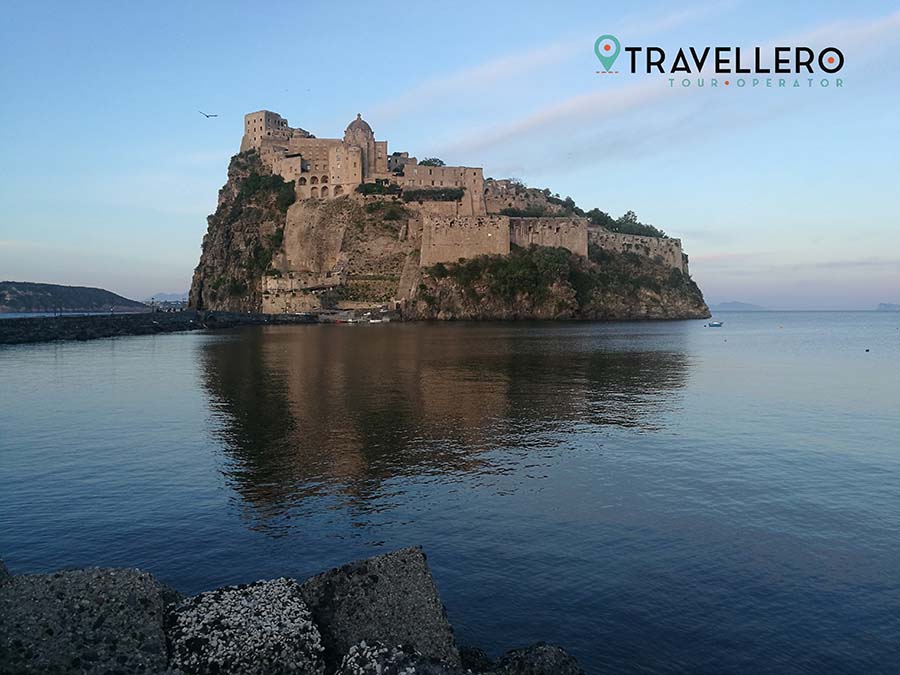From the Syracusan Greek Gerone I to the conquest of Alfonso of Aragon, to the marriage between Vittoria Colonna and Ferrante D'Avalos, to the bombings of 1809, to total abandonment and then recovery by a visionary lawyer from Ischia.
Aragonese Castle of Ischia
The Aragonese Castle of Ischia tells a history spanning twenty-five centuries with its convents, prisons, churches, beautiful gardens, and breathtaking terraces where sky and sea merge into a timeless atmosphere. In this article, everything you need to know to organize a visit to the Aragonese Castle:
1. History of the Aragonese Castle
2. Information and Accessibility
3. Itinerary of the Aragonese Castle
4. Opening Hours of the Aragonese Castle
5. Rates to Visit the Aragonese Castle

1. History of the Aragonese Castle
The Aragonese Castle boasts a history of 2500 years. Its first foundation is associated with the name of Gerone from Syracuse, who, coming to the aid of the Cumans during the war against the Tyrrhenians in 474 BC, built the first fortress with tall towers used to monitor attacks from enemy ships. Later, the island of Ischia was occupied by the Parthenopeans and then the Romans, who, in the 4th century BC, founded the city of Aenaria, located at the foot of the Aragonese Castle. Historical events, various sackings, and the succession of dominations such as those of the Visigoths, Vandals, Ostrogoths, Arabs, Normans, Swabians, and Angevins completely transformed Gerone's fortress. The eruption of Epomeo destroyed the city of Aenaria, causing a significant lowering of the ground, which, in turn, isolated the Aragonese Castle from the rest of the island. From that moment, the Aragonese Castle was nicknamed "Insula minor" and Ischia "Insula major." In the following years, Swabians and Angevins and later Angevins and Aragonese fought each other for Ischia and its castle. The Angevins saw victory in 1299 and, where the ancient Roman city of Aenaria was once located, built a port and connected the Insula minor and Insula major with a bridge. In addition to these construction works, the Angevins are credited with the construction of the Maschio on the highest part of the Aragonese Castle, which was later expanded and strengthened by Alfonso of Aragon. In 1301, the last eruption of Mount Epomeo destroyed part of the island, and the inhabitants took refuge in the Castle, which at that time was transformed into a real town, and the Cathedral of the Assumption was built. In 1423, Alfonso I of Aragon besieged and conquered the Aragonese Castle, assigning it the dual function of a fortress in times of war and a royal residence in times of peace. It was during the Aragonese domination that the Castle reached the height of its splendor, especially thanks to the presence of the illustrious D'Avalos family, who ruled the castle for two centuries. With the end of the Aragonese dynasty, the Castle was first occupied by the Spaniards and then the Austrians. Around the early 1700s, the fortress housed 1892 families, in addition to the Convent of the Clarisses, the Abbey of the Brazilians of Greece, the bishop with the Chapter and the Seminary, the Prince with the garrison. In 1912, lawyer Nicola Ernesto Mattera bought the entire castle from the State Domain, and later the related gardens. Today, the castle is guarded and managed by the third generation of the Mattera family, which ensures its opening to the public 365 days a year.
2. Information and Accessibility
The Aragonese Castle includes numerous stops and a route almost 2 km long, which can be covered in about an hour and a half. Most of the route is outdoors, so it is recommended to visit the Aragonese Castle on sunny days. Despite the presence of the elevator, the visit is not recommended for those with mobility issues. The visit paths of the Aragonese Castle of Ischia are full of steps and, in some cases, steep slopes. These characteristics do not allow for independent visits for motor-disabled people in wheelchairs. Pets are accepted. Inside the Castle, there are two panoramic cafes, a shop, and a restaurant. It is also possible to participate in guided tours with established departures or book individual or group tours at the number 0815072482.
3. Aragonese Castle Itinerary
1. Immaculate Terrace
2. Church of the Immaculate
3. Convent of S. Maria della Consolazione
4. Cemetery of the Nuns
5. Convent Belvedere
6. Monastery Cafeteria
7. House of the Sun
8. Church of San Pietro a Pantaniello
9. Wine-making presses and cellar
10. Wine press avenue
11. Bourbon Prison
12. Olive Terrace
13. Bar "Il Terrazzo"
14. Church of S. Maria delle Grazie or dell'Ortodonico
15. Ancient watchtower and defense
16. Sun Trail
17. St. Cristofaro Steps
18. Church of Our Lady of Freedom
19. Ailantus Avenue
20. Temple of the sun remains
21. Temple Terrace
22. Cathedral of the Assumption
23. Crypt of the Cathedral
24. Panoramic Loggia
25. Exit
4. Opening Hours
The Aragonese Castle is open year-round, 7 days a week, from 9 am until sunset. The last ticket is issued one hour before closing.
5. Rates
Adults € 10.00
Groups (over 20 people) € 9.00
Children from 10 to 14 years € 6.00
Children from 0 to 9 years free
